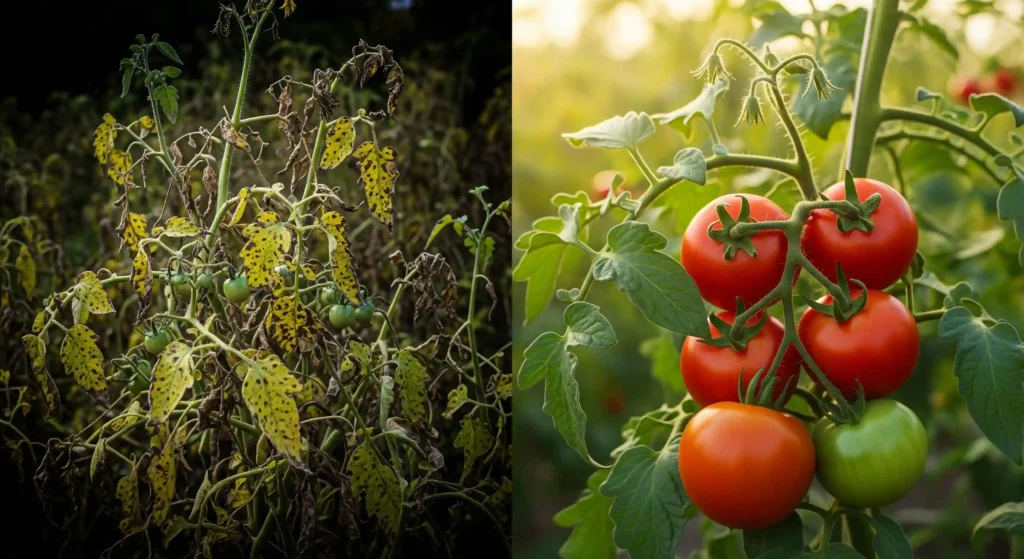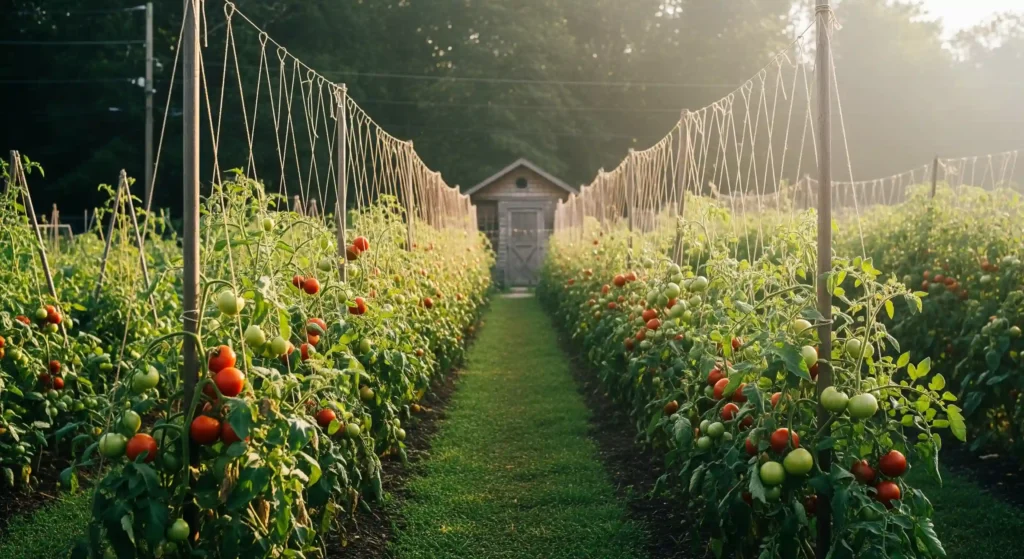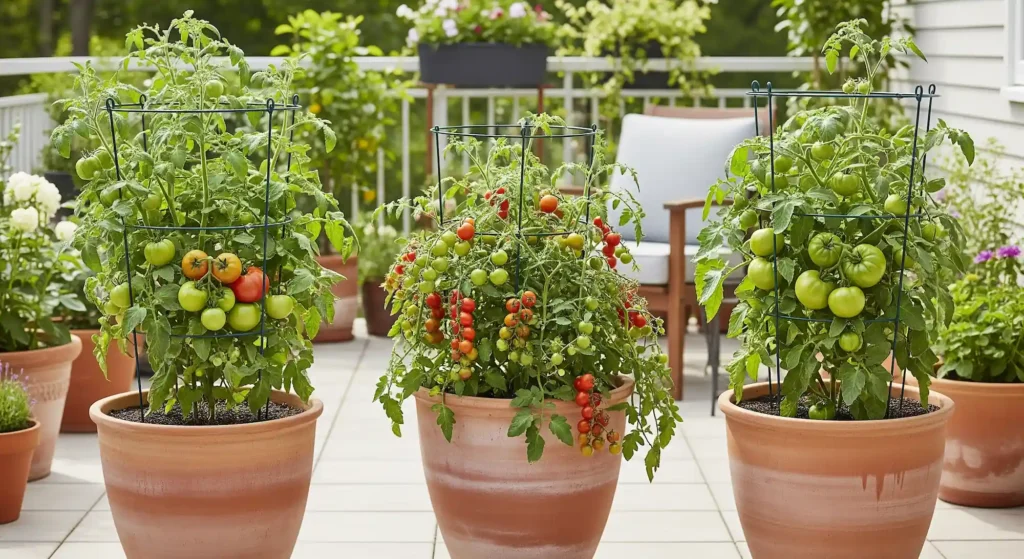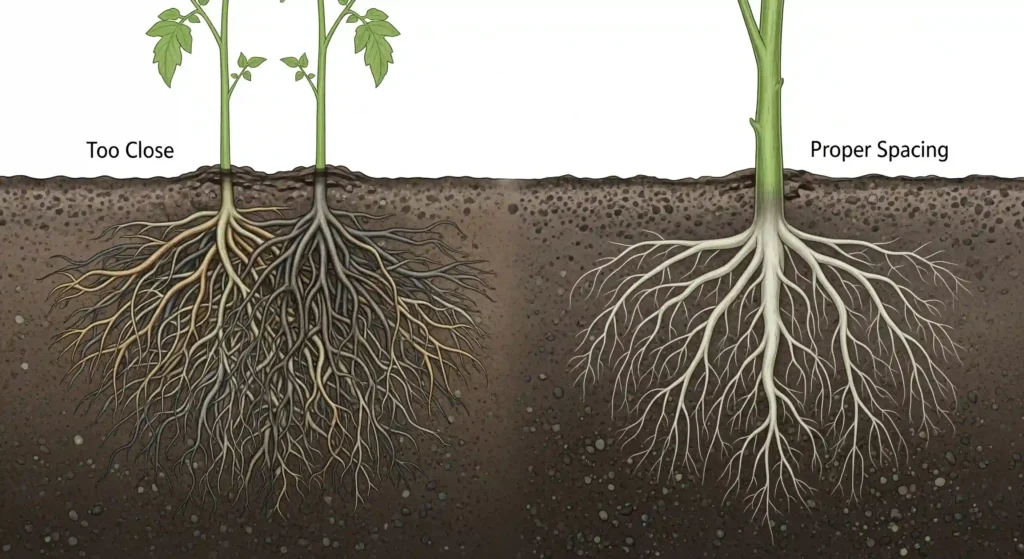Your Tomatoes Are Too Close: The Surprising Truth About Spacing
Every gardener holds dear this vision, right? Walking out to your garden, the late summer light warms your face; the air smells clearly, earthy-sweet from tomato vines. You see counters bursting with a jewel-toned harvest—plump, juicy heirlooms, sweet, pop-in-your-mouth cherry tomatoes, all destined for fresh salads, rich sauces, and sharing with pleased friends and neighbors. Everybody has that dream. We religiously water our plants, provide them the best soil and the sunniest location in the yard. But what if I told you one of the most important secrets to that dream harvest occurs on day one and it’s something many gardeners, both novice and seasoned, get wrong?
Personal space is ultimately what counts. Indeed, even with regard to flora. So let’s address the issue most likely on your mind go straight to the heart of things. Gardeners refer to the most often used vining varieties of tomatoes that grow all season long as “indeterminate,” and you must give a startling amount of space—usually from 24 to 36 inches—between each plant. Having been there, I know what you are thinking. With your small, delicate seedling in hand and two feet of empty space all around it seems like a complete waste. It nearly feels lonely. One is often tempted to maximize every square inch by tucking in one more plant.
But from humid East Coast summers to drier mountain conditions, I have discovered over many seasons of gardening here in the US that this generous spacing is your single best protection against a world of disappointment later on. Preventing tragic diseases, making sure every single fruit gets the sunlight it requires to develop to perfection, and encouraging strong growth from the roots up all depend on giving your plants that room from the beginning. By packing your tomatoes closely, you are effectively driving them into a silent, furious fight for nutrients. More crucially, you produce a thick, humid jungle where fungal diseases—including the terrible blight that can take out an overnight crop—may proliferate like wildfire.
Here’s where it becomes intriguing now. That 24–to- 36-inch rule is not global. The tomato universe is quite fascinating! If you are cultivating a smaller, busher type meant for a patio pot, what would you do? Maybe you are building in a raised bed with great efficiency. The perfect distance changes; what distinguishes a good harvest from a really amazing one is understanding how to adjust. Correcting your tomato plant spacing is about knowing what your particular plant needs to grow, not only about measuring. So let’s dig right together. To leave feeling secure and ready to provide your plants the ideal basis for their best season ever, we will precisely explain exactly how much room certain tomatoes need and why.
Why Are Cramped Tomatoes unhappy tomatoes?
Considering what’s happening both above and below the earth helps one really understand why giving your tomatoes that extra elbow room is so important. Plants under close proximity develop stress, which manifests itself in ways that could compromise your crop. Let us dissect the primary offenders.

Airflow is everything
Consider this as your garden’s equivalent of social separation. Tightly packed tomato plants overlap to form a dense canopy from their leaves. This holds humidity and stops fast evaporating morning dew. What yearns for a warm, moist, still environment? You guessed it: diseases related to fungus. Correct spacing lets air flow freely around every plant, drying the foliage and rendering it a far less appealing habitat for destructive diseases including early blight, septoria leaf spot, and powdery mildew. One especially wet summer in Pennsylvania, I discovered this the hard way when a patch of closely packed Romas succumbed to blight that spread from one plant to the next in a few days. Your first and best line of protection is allowing them room.
The Contest for Sunlight
Sun worshippers, tomatoes demand at least six to eight hours of direct sunlight to generate the energy needed for flowering and fruiting. They have to fight for that valuable light when they are too close. Their neighbors shade the inside of the patch, which causes the plants there to grow long, spindly, weak stems as they stretch desperately for the sun. Not only are these leggy tomato plants less steady, but they also generate less leaves and—above all—few flowers. And as every gardener is aware, less blossoms translate into a smaller crop. You want the energy of your plant to be directed toward creating fruit, not into a desperate dash toward the heavens.
Root Wars
A secret struggle is under way beneath the drama that is occurring above ground. A good tomato plant grows a long, two-foot or more in every direction root system. Plants that are too near entwine their roots into a jumble that fights for the same nutrients and water in the ground. Since this is underground warfare, no one plant gets all it requires to flourish. Correct spacing guarantees that every tomato plant has exclusive access to its own patch of soil, therefore enabling it to develop a strong, resilient root system capable of supporting a robust, productive plant.
Accessibility (for You!) Eases
Not to overlook the pragmatic aspect of things either. Simply said, a well-spaced garden is more comfortable for working. It gives you space to weed between your plants, apply mulch, clip suckers, and look for pests including the terrible tomato hornworm. And when it comes time to harvest, you will be able to find and pluck those perfectly ripe tomatoes without having to negotiate a twisted jungle of vines and run the danger of injuring the fruit or the plant. Good spacing improves not only tomato plant maintenance but also makes your life as a gardener simpler and more fun.
The Complete Handbook for Arranging Your Tomato Plants
Okay, you are persuaded. More space translates into happier, healthier, and more fruitful tomatoes. “More space,” though, is a relative concept. The secret is to match where you’re growing it and the sort of tomato you’re growing to the spacing. Let us now discuss the particular measurements that will equip you for success.
Determinate vs. Indeterminate: It Counts!

You first need to know kind of tomato you have. Usually found on the plant tag or seed packaging is this information.
- Determinate Tomatoes: Think of these as the “bush” kinds of tomatoes. Usually 3-4 feet tall, they develop to a fixed, small size, produce their fruit all at once during a few weeks, and then they are essentially done for the season. Roma and several other paste tomatoes are determinate. Their neat, polite demeanor suggests that they require far less space.
- Determinate tomato spacing: Aim for 18 to 24 inches (approximately 45–60 cm) between plants. This allows them the space they need to complete without crowding.
- Indeterminate Tomatoes: These are the traditional vining tomatoes, indeterminate tomatoes can be grown and produce all season long right up to the first frost. Often reaching 6-10 feet or more, they can grow to be really huge, spreading plants. Cherry tomatoes, beefsteaks, and most heirloom types are indeterminate. Their energy and scale call for additional real estate.
- Indeterminate tomato spacing: Your best bet is between 24 and 36 inches (approximately 60-90 cm). Pushing it to 48 inches (120 cm) will produce remarkably strong plants whether you have the space and want to treat them royal or whether you are utilizing big, open cages.

Tomatoes in Raised Beds: Spacing Them
Thanks to their outstanding drainage and rich soil, raised beds are great for growing tomatoes. Usually, this nutrient-dense environment allows you to get away with somewhat smaller spacing than in a conventional garden row. Still, the rules of airflow and sunlight competition hold true! Try not to get tempted to design a forest. One smart idea for raised bed tomatoes is to set aside a particular space for every plant. One popular approach, square foot gardening, advises giving one indeterminate tomato plant a 2x 2 foot square all by itself. This guarantees that it has lots of root area and that you will have space to tend to it.
Tomatoes’ Container and Pot Spacing
Growing on a balcony or a patio? Your best buddy is a container. Regarding container tomato distance, the guideline is quite straightforward: one plant per pot. That is exactly what I mean. More than one, even in a big container, will result in a vicious, yield-crushing struggle for nutrients and water.

Here, the size of the pot really counts.
- Select a pot of five gallons for a determinate variety.
- You have to go larger for an uncertain variety. The minimum is a 10-gallon pot; even better are 15 or 20 gallons.
Remember also the distances between your pots! You must let for enough airflow and sunlight exposure, much like in a garden bed. To stop the adult plants from shadowing one another out, arrange your containers such that at least a few feet separate them.
Beyond the Basics: Common Mistakes and Advice
Once you have the fundamental ideas of tomato spacing under perfect control, a few more pointers will transform your garden from good to excellent. Consider these as the secrets experienced gardeners have discovered over years—often by trial and mistake!
Remember rows
Although we have discussed the space between individual plants a lot, an accessible and thriving garden depends much on the distance between your rows. Space your rows at least three to four feet (approximately 90–120 cm) apart to create a walkway. This provides a clear path for watering, weeding, and harvesting free from compaction of the ground around the roots of your plants or inadvertent branch breakage as you squeeze past.
Trellising and Staking Matter
The way you intend to support your tomatoes directly affects spacing. You are promoting vertical growth whether you are training tomatoes on a string trellis or anchoring tomatoes with a single, strong stake. The plant has a smaller footprint because of its upward concentration; you may usually get away with spacing them on the closer end of the advised range (e.g., 24 inches for indeterminate species). To fit that more generous, rounder form, though, if you are using wide, circular tomato cages allowing the plant to develop bushy, you will want to lean toward the more generous end of the spacing spectrum (36 inches or more).
A Notes on Companion Planting
One excellent technique to discourage pests and draw pollinators is to put tomatoes alongside useful herbs and flowers. Those friends, though, also require room! Plant buddies like basil, marigolds, or parsley next to your tomatoes at the perimeter of the tomato’s allotted area rather than straight at its base. This keeps them from vying with the tomato’s roots for nutrients and water while yet offering all their fragrant advantages.
The First Mistake to Steer Clear of
One mistake I see beginning gardeners repeatedly make is underestimating the mature size of that little seedling. Looking at a 6-inch tall plant from a nursery and assuming it would remain modest and respectful is quite simple. Not that will. That small plant dreams of being a vast, fruit-filled monster. Planting solely on the current size of the seedling rather than its future potential is one of the largest blunders in tomato plant spacing. Leave always room for your plant’s full-grown, end-of-season form. When unsure, always allow more room rather than less. You will be thanked by your future self and plentiful crop.
Pruning for Space: Training Your Tomatoes for a Neater Garden
Pruning is how you guide the show, if spacing is your stage setting. The shape and size of your tomato plants will be largely influenced by how you prune—or decide not to prune—them, thereby determining their actual required area. Consider it as a sophisticated approach to maximize your garden’s design.
The Single-Stem Approach for Restricted Areas
This is the gold standard for gardeners trying to maximize their plants in a limited footprint. Eliminating all the suckers—the tiny sprouts that develop in the “V” between the main stem and a branch—is the single-stem approach. This drives the plant to devote all its energy to one primary vine you train straight up a pole or string. The gains? It produces a very thin plant that allows great ventilation and lets you space indeterminate variety as near as 18 to 24 inches apart. The trade-off is that your overall yield per plant could be somewhat less than with other techniques even if the fruits might ripen somewhat quicker.
The Multi-Stem Approach for a Bushier Yield
Allow one or two suckers to grow into extra main stems if you have a little more space to spare and wish for the maximum harvest per plant. Usually the strongest and a perfect contender to be a second leader, the sucker that develops right under the first bloom cluster is You will need to give a plant trained to two or three stems more room; stick to the 36-inch or wider advised width. She will be much wider and busher. Although it keeps the plant more under control than a totally unpruned behemoth, this is a great middle-ground with a bigger yield than the single-stem approach.
A Light Hand with Certain Tomatoes
And what of our busily determined, glossy friends? Here the golden rule is to cut extremely little, if at all. Genetically designed to develop their fruit on the branches they create, determinate tomatoes Starting to prune off suckers and branches means that you are literally cutting off your future supply. Just to increase airflow near the base of the plant, the only pruning I advise for determinate kinds is to cut the leaves below the first bloom set once it develops.
Thus, also take into account your intended pruning while you are designing your garden and choosing your distances. A bushy, multi-stemmed plant requires significantly more horizontal space than a severely clipped single-stemmed one. You really become the master of your tomato patch by this interaction between spacing and trimming.
Finish by allowing them space to flourish
I realize it can feel contradictory. We are tempted to plant more in our search for a huge crop. The real key, though, is not in how many plants you can squeeze in but rather in how effectively you enable every one to flourish. You are doing exactly that by allowing them the time required.

The most crucial topics are briefly recapulated here:
- Your secret weapon for avoiding disease and producing a larger, better tomato crop is appropriate tomato plant distance.
- Give bushier, determinate varieties 18-24 inches and vining, indeterminate types 24-36 inches.
- Always give ventilation and sunlight some thought; they are buddies of your plants.
- The guideline in containers is always one plant every pot.
At first, it could seem odd given a small plant so much real estate in the garden bed. Still, trust the process. Starting with the correct tomato plant spacing from the time you plant will help to create a season full of mouthwatering, pest-free, plentiful homegrown tomatoes.
Often asked questions include
If you plant tomatoes too closely, what happens?
Tomatoes planted too near drive them into a severe fight for soil nutrients, sunlight, and water. Usually, this stress results in smaller, leggier plants with less flowers and, so, a far reduced fruit output. More significantly, the lack of airflow produces a humid climate ideal for fungal infections to proliferate rapidly and destroy your whole crop.
In one hole may I put two tomato plants?
Although theoretically conceivable, experienced gardeners strongly oppose it. This generates the perfect competition setting right at the root ball. Rather of one healthy, robust, and productive plant, you will almost invariably find two severely stunted plants struggling all season long. Giving one plant all it requires is far better.
Cherry tomato planting distances should be such-that they vary
Given their prodiveness as cultivators, this is a really interesting question! Most cherry tomato kinds are indeterminate, which means they are vining plants that will flourish all season long. You ought to treat them as such and allow them lots of room. Just as with a big beefsteak variety, especially if you intend to support them with a big cage or trellis and allow them reach their full, gorgeous potential, plan for at least 24 to 36 inches between plants.









